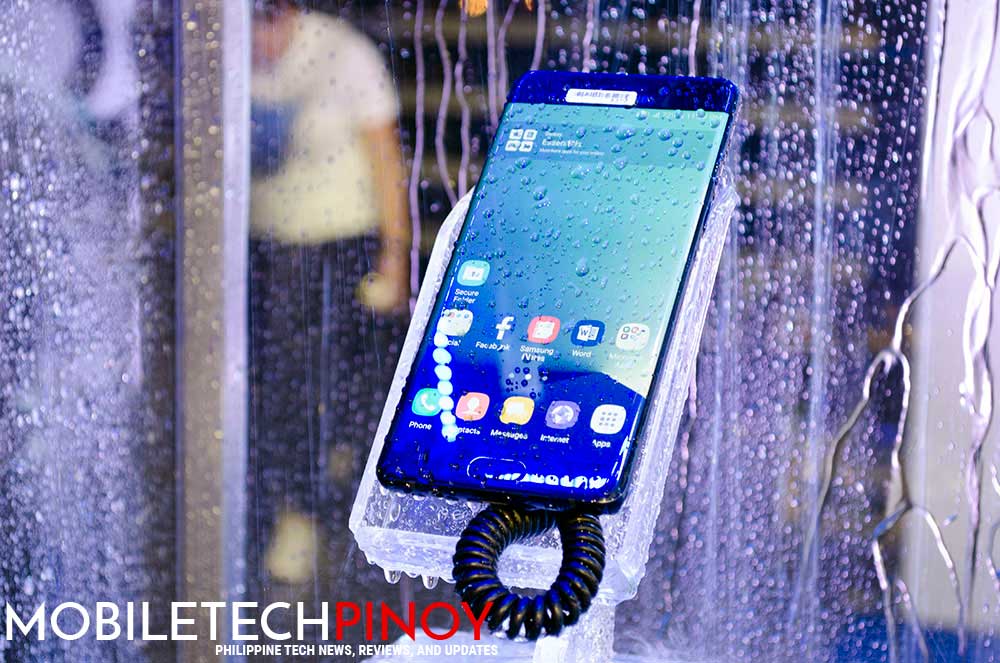
The Galaxy Note Series has consistently set the standard for phablets year after year. Now, it’s time for the Samsung Galaxy Note 7 to have a whack at it. Is it the new phablet to beat for 2016? I was fortunate enough to get some hands on time with it to find out.
Samsung Galaxy Note 7 Specs
- 5.7″ QHD Super AMOLED display (1,440 x 2,560 resolution, 515ppi)
- 2.3GHz Exynos 8890 octa-core processor
- Mali 880 MP12 GPU
- Android 6.0 Marshmallow
- 4GB RAM
- 64GB internal storage, expandable via microSD up to 256GB
- 12mp AF rear camera with OIS, f/1.7 aperture, and LED flash
- 5mp FF front camera with f/1.7 aperture
- 4G/LTE
- WiFi
- Bluetooth
- GPS with A-GPS
- Fingerprint scanner
- Iris scanner
- IP68 dust and water resistance
- USB Type C
- S-Pen
- 3,500mAh battery, fast charging supported
- Price: Php39,990
Build Quality and Design
The Note 7 inherits a lot of design cues not just from its predecessor the Note 5, but the Galaxy S7 Edge as well. In fact, it basically looks like a slightly bigger version of the S7 Edge.

It’s easier to hold thanks to a sloped back and reduced width from 76.2mm down to 73.9mm versus the Note 5. Perhaps contributing to the narrowing of its width is the screen’s dual edge design, similar to the S7 Edge.

Here, you can see it next to a Cherry Mobile M1 which has a 5.5 inch screen. The Note 7 still manages to be the slimmer of the two.

Of course, there are a few things that can truly be called upgrades. First, it has an IP68 rating for dust and water resistance, making it the first such Note to get that kind of protection.

Samsung also swapped out Gorilla Glass 4 panels and went with the newer and tougher Gorilla Glass 5.
The Display

The Note 7 packs an enviable 5.7″ QHD Super AMOLED display with a resolution of 1,440 x 2,560 and a pixel density of 515ppi. While the resolution is impressive, what’s really striking about it is how vivid images are versus other display technologies. It’s capable of displaying true black, resulting in theoretically infinite contrast. The calibration is also as good as its ever been. Whereas older Notes would sometimes come off as being too saturated and cartoonish, Samsung’s Super AMOLED displays of today have much better color representation.
S-Pen
If there’s anything that sets the Note Series apart, it’s the S-Pen. The Note 7 is certainly no different. I wasn’t able to fully explore the software designed specifically for the S-Pen, there have been a lot of physical improvements to the pen itself that should help improve its usability, software features or not.

First, its tip now measures just 0.7mm so it more closely resembles the tip of an actual ballpoint pen. Second, pressure sensitivity has been bumped up and they’ve even managed to reduce the latency even further. Third, it can now work even underwater, so if you’re stuck in the rain taking notes, the S-Pen will keep working as you do.
Performance
The Samsung Galaxy Note 7 is driven by the company’s home-baked Exynos 8890 SoC. It’s the same chip found on both the S7 and S7 Edge, which is a bit of a disappointment. That’s not to say that it’s not one of the best chips that can be found in a smartphone, because it is. However, the Note Series represents an entire step up in terms of performance from the Galaxy S series and has typically been gifted with the better processor between the two.

Another slight letdown is that it only comes with 4GB RAM. To be honest, there’s still not a lot of reason for phones to come packing more than that, which is why Samsung may have opted to stick to just 4GB instead of following the trend into 6GB RAM territory and above.
Thankfully though, it seems that Samsung has set the bar higher for storage requirements on their flagships, with the Note 7 packing 64GB RAM. This can be expanded further via microSD up to 256GB.
Additional Features
Easily the best new feature that Samsung has introduced in the Galaxy Note 7 is its iris scanner. It’s built into the front of the device on the other side of the earpiece from the front camera. Once it’s been set up, unlocking the device is almost instantaneous. I’d say it’s even faster than if you were to use the fingerprint scanner.

Another less heralded feature is its Battery Saver Mode, which is said to be able to extend the battery life by an additional 35 hours. There are three different battery saving modes, each one switching off or limiting more features than the other. At the Max preset, the Note 7’s resolution is cut down to just 720p to reduce the load on the GPU.
So Should You Buy the Samsung Galaxy Note 7?
There’s no doubting the Note 7 sets a new standard for today’s phablets. However, it’s lead over the competition isn’t quite as clear cut as it used to be. While it still has arguably the best screen you can get on a phone, its Exynos 8890 SoC isn’t quite as undisputed. It’s also beat in terms of RAM. There are quite a few smartphones coming out with 6GB RAM, some of which aren’t necessarily flagship class.

However, I’d still say that the Samsung Galaxy Note 7 has earned its Php39,990 price tag. Not only does it have possible the best screen you can get, but it also comes with Gorilla Glass 5, an iris scanner, and S-Pen functionality that no other phone is able to offer yet. Would I buy it? If I had the money, I certainly would.


